Berita & analisis pasar
Tetap selangkah lebih maju di pasar dengan wawasan ahli, berita, dan analisis teknikal untuk memandu keputusan trading Anda.

Most traders understand EA portfolio balance through the lens of traditional risk management — controlling position sizes, diversifying currency pairs, or limiting exposure per trade.
But in automated trading, balance is about deliberately constructing a portfolio where different strategies complement each other, measuring their collective performance, and actively managing the mix based on those measurements.
The goal is to create a “book” of EAs that can help diversify performance over time, even when individual strategies hit rough patches.
A diversified mix of EAs across timeframes and assets can, in some cases, reduce reliance on any single strategy. This approach reduces dependency on any single EA’s performance, smooths your overall equity curve, and builds resilience across changing market conditions.
It’s about running the right mix, identifying gaps in your coverage, and viewing your automated trading operation as an integrated whole rather than a collection of independent systems.
Basic Evaluation Metrics – Your Start Point
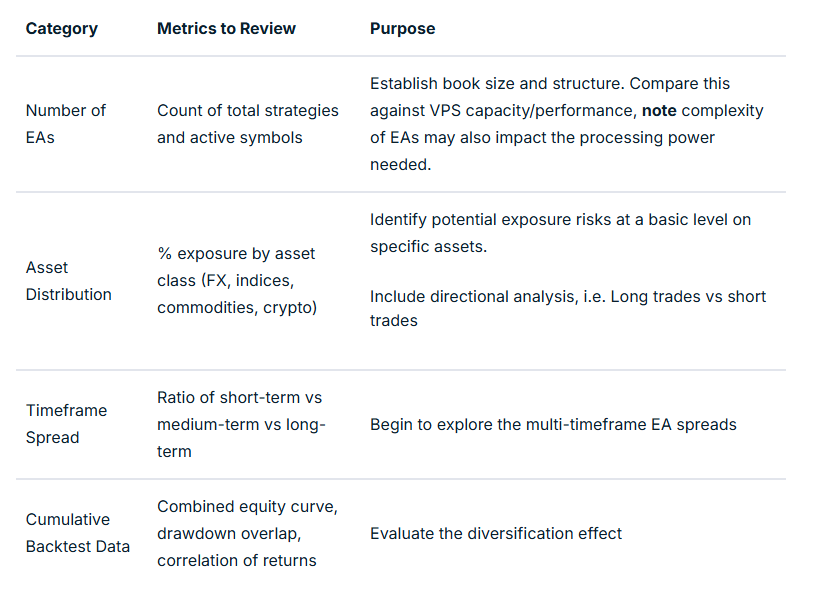
Temporal (timeframe) Balancing
When combined, a timeframe balance (even on the same model and instrument) can help flatten equity swings.
For example, a losing phase in a fast-acting M15 EA can often coincide with a profitable run in an H4 trend model.
Combining this with some market regime and sessional analysis can be beneficial.
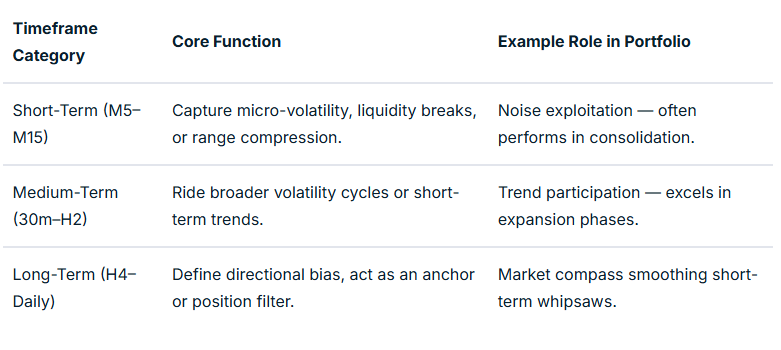
Asset Balance: Managing Systemic Correlation Risk
Running five different EAs on USDJPY might feel diversified if each uses different entry logic, even though they share the same systemic market driver.
But in an EA context, correlation measurement is not necessarily between prices, but between EA returns (equity changes) relating to specific strategies in specific market conditions.
Two EAs on the same symbol might use completely different logic and thus have near-zero correlation.
Conversely, two EAs on a different symbol may feel as though they should offer some balance, but if highly correlated in specific market conditions may not achieve your balancing aim.
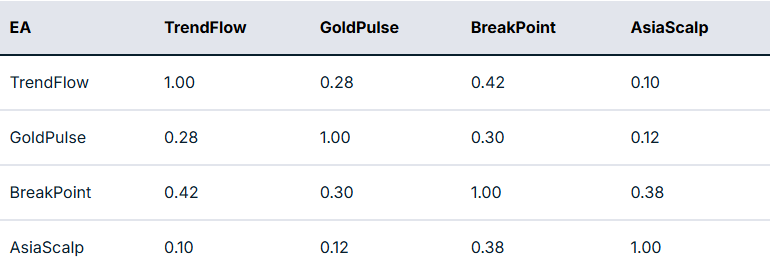
In practical terms, the next step is to take this measurement and map it to potential actionable interventions.
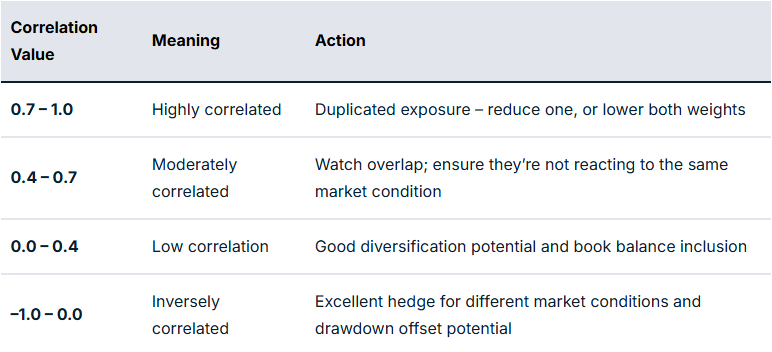
For example, if you have a EURUSD Trend EA and a GBPUSD Breakout EA with a correlation of 0.85, they are behaving like twins in performance related to specific market circumstances. And so you may want to limit exposure to some degree if you are finding that there are many relationships like this.
However, if your gold mean reversion EA correlates 0.25 compared to the rest of your book, this may offer some balance through reducing portfolio drawdown overlap.
Directional and Sentiment Balance
Markets are commonly described as risk-on or risk-off. This bias at any particular time is very likely to impact EA performance, dependent on how well balanced you are to deal with each scenario.
You may have heard the old market cliché of “up the staircase and down the elevator shaft” to describe how prices may move in alternative directions. It does appear that optimisation for each direction, rather than EAs that trade long and short, may offer better outcomes as two separate EAs rather than one catch-all.
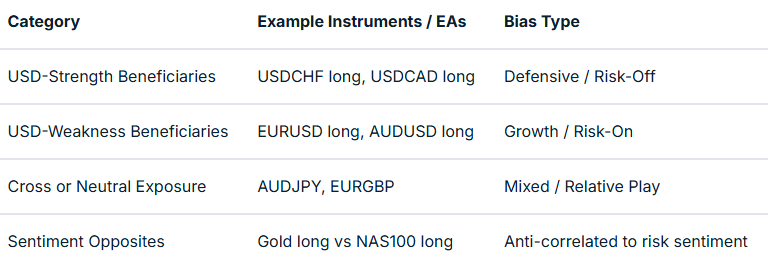
Market Regime and Volatility Balance
Trend and volatility states can have a profound impact on price action, whether as part of a discretionary or EA trading system. Much of this has a direct relationship to time of day, including the nature of individual sessions.
We have a market regime filter that incorporates trend and volatility factors in many EAs to account for this. This can be mapped and tested on a backtest and in a live environment to give evidence of strategy suitability for specific market conditions.
For example, mean reversion strategies may work well in the Asian session but less so in strongly trending markets and the higher volatility of the early part of the US session.
As part of balancing, you are asking questions as to whether you actually have EA strategies suited to different market regimes in place, or are you using these together to optimise book performance?
The table below summarises such an approach of regime vs market mapping:
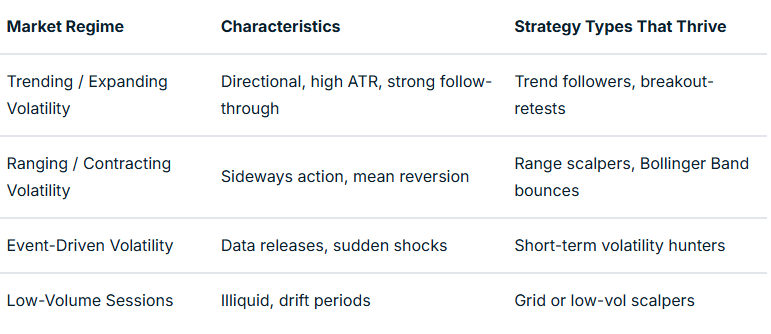
Multi-Level Analysis: From Composition to Interaction
Once your book is structured, the challenge is to turn it into something workable. An additional layer of refinement that turns theory and measurement into something meaningful in action is where any difference will be made.
This “closing the circle” is based on evidence and a true understanding of how your EAs are behaving together. It is the step that takes you to the point where automation can begin to move to the next level.
Mapping relationships with robust and detailed performance evaluation will take time to provide evidence that these are actually making a difference in meeting balancing aims.
To really excel, you should have systems in place that allow ongoing evaluation of the approaches you are using and advise of refinements that may improve things over time.
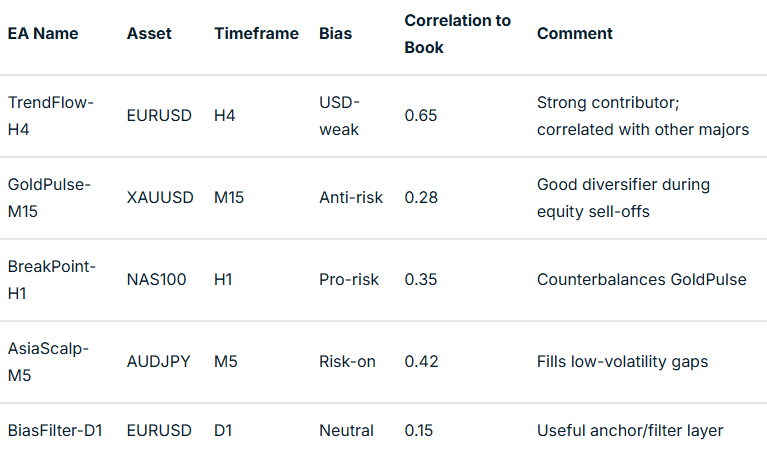
What Next? – Implementing Balance in Practice
Theory must ultimately translate into an executable EA book. A plan of action with landmarks to show progress and maintain motivation is crucial in this approach.
Defining classification tags, setting risk weights, and building monitoring dashboards are all worth consideration.
Advanced EA traders could also consider a supervisory ‘Sentinel’ EA, or ‘mothership’ approach, to enable or disable EAs dynamically based on underlying market metrics and external information integrated into EA coding decision-making.
Final Thoughts
A balanced EA portfolio is not generated by accident; it is well-thought-out, evidence-based and a continuously developing architecture. It is designed to offer improved risk management across your EA portfolio and improved trading outcomes.
Your process begins with mapping your existing strategies by number, asset, and timeframe, then expands into analysing correlations, directional bias, and volatility regimes.
When you reach the stage where one EA’s drawdown is another’s opportunity, you are no longer simply trading models but managing a system of EA systems. To finish, ask yourself the question, “Could this approach contribute to improved outcomes over time?”. If your answer is “yes,” then your mission is clear.
If you are interested in learning more about adding EAs to your trading toolbox, join the new GO EA Programme (coming soon) by contacting [email protected].


We're learning a lot about the Trump administration 2.0, it's going to be hard to bed down, it has a nationalistic principle like never before and unlike the first administration thought bubbles will turn into action rightly or wrongly as all checks and balances now don’t exist. What's also different between Trump 1.0 and Trump 2.0 is using The US equity markets as a benchmark for performance. It's been fascinating to see just how silent on the markets the president has become, for example in his first term it was his favourite thing to talk about on social media and there's good reason for that.
From November 6 2016 to the following February in 2017 the S&P 500 climbed 13 percent and closed out the full year with an impressive 20% gain. If we take the same dates this time around: November 5 2024 to this February 2025 it's a completely different story up the S&P 500 is up just on 2% (and has fallen into the red if we include March trading) and that's despite the fact that in the first several weeks after the November election markets were on tear. You also need to compare the S&P to difference peers across the world - look at Europe, where markets have surged, China markets have also bounced even the Australian market has made records.
There have been some interesting deep dives into this situation over the last few weeks, here are some stark stats that highlight that this time around Trump might not care about the markets as he once did. In his first term, Trump posted about the stock market 156 times. Since the start of 2024, he’s only mentioned it once.
The political messaging has also changed, in his first term he constantly used positive economic developments for example: lower unemployment (he used terms ‘lowest ever seen’ however this was not factually correct), a surging stock markets, infrastructure spending in key states, manufacturing booming on his watch – all where used constantly to reconfirm that he was the difference. In his second term this has evaporated – messaging is focused on the debt ceiling, government spending and the task of DOGE, tariffs and nationalising everything. Now that’s not to say that he won’t return to the good old days of market-led commentary that we traders had learned to love.
But it there is no denying that the difference striking It also reenforces that the Trump trades that have now fizzed out may have more to lose. Just look at the reactions to the Trump trade over the past 10 days - market sentiment has soured, the narrative around the U.S. economy has turned dark and there is limited bright news coming. Now market “vibes” shouldn’t matter, they undeniably do.
Again look at what was happening a mere 6 weeks ago just before Trump’s inauguration, The proposed tariffs were viewed as inflationary but potentially beneficial for domestic manufacturing. Well that narrative has now flipped - The prevailing thought is that they’re seen as harmful to growth, with early inflationary effects likely stemming from importers rushing orders to avoid price hikes. Similarly, efforts to rein in federal spending, once praised as fiscal discipline, are now seen as a potential drag on economic momentum.
Then we just have to look at recent data: Retail sales posted their steepest decline in nearly two years, consumer confidence saw its sharpest drop in four years, and optimism among small businesses appears to have peaked. Getting back to the statistics that matter have a look at Citi index’s surprise index – the U.S. data is now consistently missing Wall Street forecasts, while Europe’s economy continues to outperform. The initial post-election reaction where based on several pillars ‘America First’—higher growth, higher inflation, higher interest rates, digital and a stronger dollar.” One by one, those assumptions are crumbling.
Just look at Bitcoin down 26% from its January high. U.S. stocks have dropped 4.5% from their recent peak—not even a technical pull back, but a sharp contrast to the relative strength in European and some Asian market markets. Its not just the Trump trade that is feeling the difference have a look at the impact the new administration is having on Tesla.
Being the face of DOGE and the President’s closest alley has downsides. Telsa is currently facing declining sales, especially in Europe and other zones that see Musk as a root cause for current issues. Now increased competition is a factor (have a look as just how well BYD is doing), Musk’s aggressive cost-cutting and controversial political moves aren’t helping.
Tesla shares have plunged 40% since mid-December. A Trump trade that is thriving - the Russian Ruble, up nearly 30% against the dollar this year with no sign of slowing down. Take that as you will.
Ultimately sentiment is always in a state of flux as we all know, but there is a telling trend in the new administration that is clearly a drag for the Trump trades as we have known them over the past periods. The question will be - can the president revive them, or have they officially been killed off? The president’s approval rating might be the answer to that telling question.
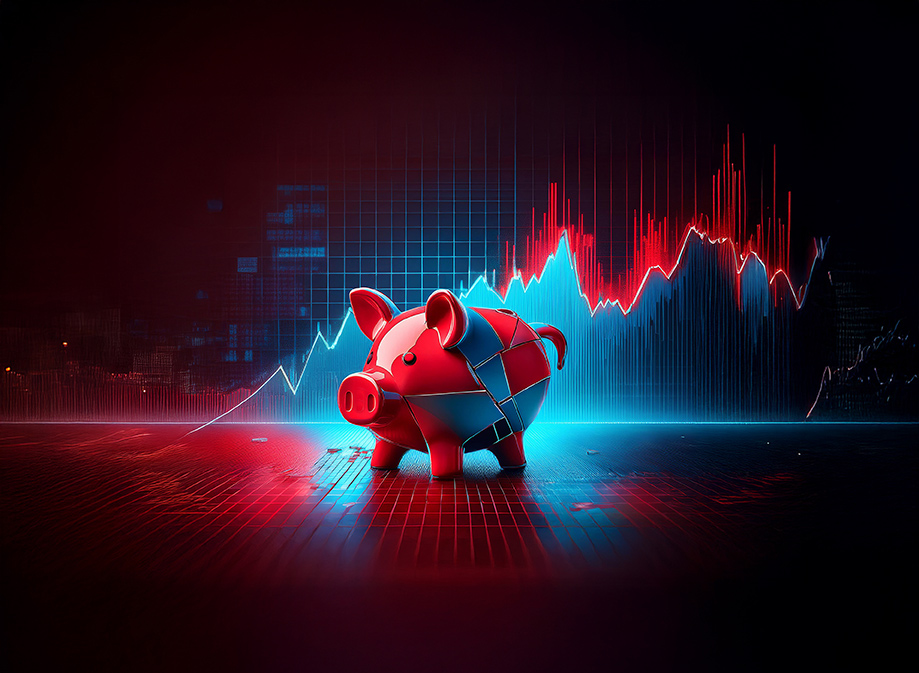

This coming Friday sees the January core PCE inflation data – the Fed’s preferred measure of inflation. Now most are forecasting that it should confirm that inflation has eased compared to this time last year. The consensus estimate has the monthly increase at 0.2 per cent with the annual rate at 2.5 per cent.
Now that is premised on a range of factors, they are also based on the fact the newly installed administration was not in power when these numbers were being collated. For now then – here are the key issues of the PCE read this Friday: Inflation Expectations: A temporary blip? Or is this the ‘transitory v structural debate again? – Upside impactor Several surveys are showing some upward movement in price expectations, mainly down to tariffs and other new external impacts.
Most don’t see this as a sign of a new inflationary trend but that is cold comfort considering how wrong these forecasts have been over the past three years. Case in point here is the University of Michigan’s 5 to 10 year inflation expectations which jumped to 3.5 per cent in February release, highest of this cycle. The caveat is that while this figure is high, historically this read has run above actual inflation, even when inflation was stable at 2 per cent, even so – a 1.5 per cent miss seems way out and even a 2.8 to 2.9 per cent read would be an issue for further cuts and the current US inflation story.
Other things to keep in mind: Tariffs were front and centre in February and clearly remain a political and geopolitical risk/threat. It should die down in the coming weeks as the administration settles in, the news cycle moves and the size of the tariffs retreat – that is until something causes the President to react. But March should be quieter – but the year will be volatile.
Countering the University of Michigan survey is the New York Fed’s, which hasn’t shown a major shift. If the increase in expectations were widespread, this would move the dial and would be more concerning. It makes the NY Fed data all the more interesting ahead of its launch.
We should also point out February’s manufacturing PMI showed rising input and output prices, while service sector price indices eased – why? Tariffs. This aligns with the 10% tariffs on Chinese imports that kicked in earlier this month.
With 25% steel and aluminium tariffs set for March 12, some price pressures may persist in March. Used Car Prices: A Temporary Divergence? – Down side impactor Used car prices in CPI have been running hotter than expected, especially relative to wholesale prices, which typically lead by a few months. And, this even after the surge in used car prices during the COVID era.
This market has remained above trend but is easing a Manheim wholesale used car prices fell 1.1 per cent month on month in early February, reinforcing our view that CPI inflation in this category has limited room to rise. If consumer demand were truly driving higher prices, we’d expect to see wholesale prices moving up as well which hasn’t happened. New York Congestion Pricing: Is this one and done?
A big policy pitch from the President for the state of New York was the congestion charging throughout New York City. True to its word the Trump administration revoked approval for congestion pricing in New York City, which had gone into effect in early January. This is likely to be the reason for the 2.6 per cent month on month spike in motor vehicle fees within CPI.
If the fee is ultimately scrapped, we’d expect an equivalent pullback in this CPI category. But with legal challenges keeping the fee in place for now – it was a double hit. One to watch.
Housing & Shelter: Watching LA Zillow’s single-family rent index rose 0.33 per cent month on month in January, consistent with shelter inflation continuing to slow – but still growing above historical averages. However it is not even across the country - Los Angeles rents spiked 1 per cent month on month - the biggest monthly jump since early 2022. The recent fires may have played a role, and if this strength persists, we could see upward pressure on shelter inflation later this year.
Median home prices remained flat in January, and with the broader housing market cooling, long-term upside risk to shelter inflation remains limited. In short, this Friday’s PCE is going to a line ball read – any hit that inflation is continuing to defy expectations as it has since September, the Fed will be dealt out of the rate market in 2025 and the USD, US bonds and risk exposures with debt are going to see reasonable movements. Which brings us to the other elephant in the market trading room – Tariffs on silver things.
Tariff Changes on Steel and Aluminium: Who really pays? We have been reluctant to write about the steel and aluminium tariffs that were announced on February 11. The Trump administration confirmed its plan to reinstate full tariffs on imported steel and aluminium—a move that will significantly impact both industries and consumers.
These tariffs are scheduled to start in early March, these Section 232 import tariffs will impose a 25% duty on steel and aluminium products, with aluminium tariffs rising from the previous 10% to 25%. Right now every nation on the planet (including Australia) is in Washington trying to wiggle their way out of the impending price surge – so far there is radio silence from the administration on if it will budge on any of the changes. Memory Lane If we take the 2018 tariffs as a guide, history suggests that once domestic stockpiles are depleted and buyers turn to global markets, U.S. prices will likely rise to reflect most of these duties.
However, exemptions may still be granted, particularly for aluminium, where the U.S. depends heavily on imports about 85% of aluminium consumption comes from overseas. While U.S. importers will bear roughly 80% of the tariff costs, exporters may need to lower prices to remain competitive—assuming they can’t find better pricing in other markets. Other things to be aware of from a trading point of view - The U.S. imports ~ 70 per cent of its primary aluminium Canada.
Who is the biggest play in that Canadian market? Rio Tinto. And it's not just Canada Rio Tinto ships approximately 1.75 million tonnes of aluminium annually from Canada and Australia.
Nearly 45 per cent of Rio Tinto’s U.S. aluminium sales are value-added products, which carries a premium of $200-$300 per tonne over London Metal Exchange (LME) prices. That is something that very much irks the President. Couple this with the fact physical delivery in the U.S. is also at a premium price and that gives you an average price estimate that could rise by ~40 per cent to approximately $1,036 per tonne ($0.50/lb), up from the 2024 average of $427 per tonne.
The thing is Rio Tinto itself is forecasting strong demand in North America, and its Value-add pricing is unlikely to change as domestic suppliers can’t easily replace the volumes it needs. In short, price pressure is coming – and suppliers will likely win out over the consumer. So what about Steel?
The U.S. imports 25-30 per cent of its steel so it’s not as reliant on this product as aluminium, but 80 per cent of those imports are currently exempt under Section 232 which is about to scrap it. That means the tariffs will impact around 18 million tonnes of steel imports annually, with: 35-40 per cent being flat products, 20-25 per cent semi-finished steel, and the rest covering long steel, pipes, tubes, and stainless steel. The Trump administration has signalled concerns over semi-finished steel imports, particularly Brazilian slab imports (~3-4 million tonnes per year).
What Does This Mean for Steel Prices? All things being equal - U.S. domestic steel prices will rise in full alignment with the 25% tariff on affected imports. The short and tall of it For both steel and aluminium, the reintroduction of tariffs means higher prices for U.S. buyers, particularly once inventories run down and imports reflect the new duty rates.
While exemptions remain a possibility, businesses reliant on imported metals should prepare for cost increases and potential supply disruptions. Traders should be ready for volatility, margin changes and erratic conditions as the administration rages over pricing issues.
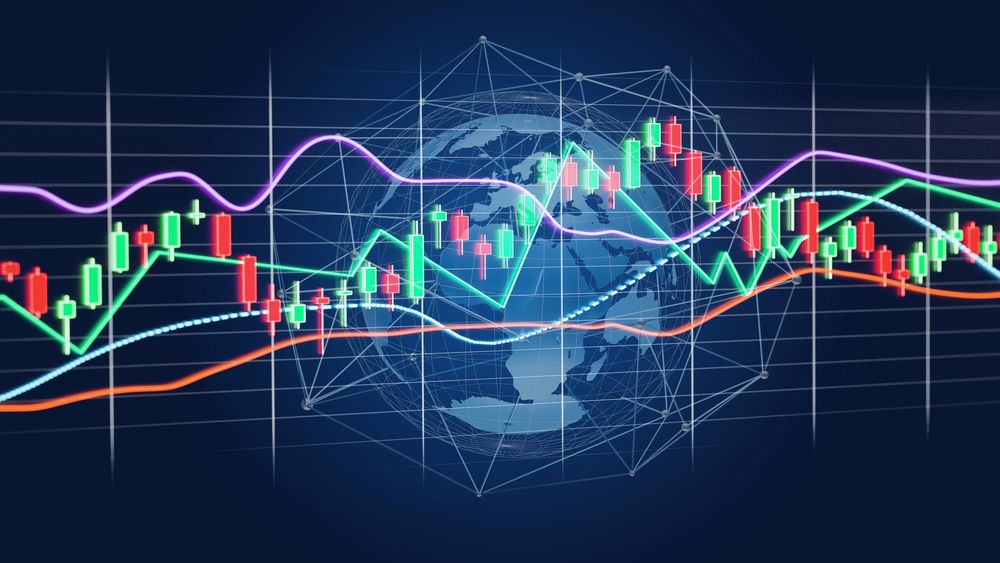

Many traders rely on breakouts as key trading opportunities. The logic is simple: when price moves beyond a well-defined support or resistance level, it signals strength and continuation. However, markets are deceptive, and more often than not, these breakouts turn into fakeouts—also known as false breakouts or traps.
A fakeout occurs when price briefly breaks a key level, triggers breakout traders into positions, and then reverses sharply in the opposite direction. This traps traders on the wrong side, often leading to stop-loss hits and unnecessary losses. Fakeouts are particularly frustrating for traders who follow textbook breakout strategies because they often get stopped out right before the market moves in their original direction.
However, these false breakouts aren't just random occurrences—they happen due to liquidity grabs, institutional trading strategies, and market psychology. Why You Need to Understand Fakeouts Understanding how and why fakeouts occur is a crucial skill for price action traders because: Fakeouts trap retail traders, and recognizing them early helps you avoid costly mistakes. Fakeouts offer high-probability reversal setups for traders who can spot them in real-time.
Fakeouts reveal where liquidity exists—a key factor in how institutions trade. Learning to trade against fakeouts allows you to think like professionals rather than follow the herd. This article will break down what fakeouts are, why they happen, how to identify them, and most importantly—how to avoid getting trapped and profit from them instead.
What is a Fakeout in Price Action? Definition: A fakeout (false breakout) occurs when price briefly moves beyond a significant level (support, resistance, or a trendline) but fails to continue in the breakout direction and reverses, trapping traders who entered on the breakout. Fakeouts happen in all markets, asset classes and across all timeframes, making them a universal challenge for traders.
Why do Fakeouts Happen? Four main reasons are cited in the trader literature, for each of these explanations as to what may be happening and examples will be given. Liquidity Hunting (Stop-Loss Grab by Institutions) Large institutional traders execute massive trades that require a significant number of buy or sell orders to fill their positions.
Since liquidity is invariably concentrated either side of key levels, institutions will often trigger stop-losses before reversing price. How this works: Retail traders place stop-losses just beyond support and resistance. Smart money (institutions and market makers) push prices beyond these levels to trigger stops and create liquidity.
Once stop orders are triggered, institutions enter their own trades at optimal prices before reversing the move. Example: EUR/USD is trading near strong resistance at 1.1000. Many traders expect a breakout and place buy orders above this level.
Meanwhile, traders who are short have stop-losses above 1.1000. Institutions push prices just above 1.1000, triggering stop-losses and breakout buy orders. As soon as enough orders are activated, institutions reverse the price downward, trapping long traders.
Retail Trader Traps (Herd Mentality Exploitation) Retail traders often trade breakouts in predictable ways, meaning their behaviour is easy for professionals to manipulate. Many use simple breakout strategies, where they enter long trades above resistance and short trades below support. Institutions exploit this retail behaviour by triggering these breakouts and quickly reversing price, often resulting in retail traders exiting trades in panic.
Example: Price approaches a well-established support level at $50.00. Retail traders place buy orders right at $50.00, expecting a bounce. Instead, price briefly dips below $50.00, stopping out traders who had tight stop-losses below support.
The market then rebounds strongly, leaving stopped-out traders frustrated and missing the real move. Market Manipulation (Whale Activity & Stop Runs ) Large market participants, often called whales, engage in strategies that artificially create breakouts to lure in traders. This is a more aggressive form of liquidity hunting.
How whales manipulate price: They place large fake buy or sell orders to create an illusion of demand or supply. Retail traders react by jumping in on the breakout, adding liquidity. Once enough traders enter, whales reverse the move and trap breakout traders.
Example: Bitcoin breaks above $100,000, attracting thousands of breakout traders. Shortly after, price suddenly dumps to $98,500, triggering stop-losses before eventually rallying higher. Low Volume Breakouts (Weak Buying/Selling Pressure) A true breakout should be accompanied by strong volume, confirming that buyers or sellers are committed to pushing the move further.
Fakeouts often happen when price breaks a key level but lacks volume, signalling that the breakout is weak and likely to fail. How to Spot Low Volume Fakeouts: A breakout occurs on low volume, meaning there is no real buying or selling pressure behind it. Price moves beyond a key level but quickly returns inside the previous range.
A sudden spike in volume after a reversal confirms that institutions entered against the breakout. Example: Gold breaks above major resistance at $2,700 but does so on low volume. The price moves slightly higher but quickly falls back below $2,700, confirming a fake breakout.
How to Avoid Getting Caught in Fakeouts There are three VITAL ways in which you can look to reduce the chance of getting caught in a fakeout. These are as follows: Wait for Confirmation Before Entering Breakout Trades One of the biggest mistakes traders make is entering trades immediately after a breakout. A breakout should be confirmed before entry, or it risks being a fakeout.
How to confirm a breakout: Wait for a strong candle closing beyond the breakout level on your relevant timeframe (ideally over multiple timeframes rather than taking action intra-candle before it is mature. Acting on candle bodies rather than wicks as a general rule may be prudent. Observe whether price holds above support/resistance on a retest.
It is thought that up to 35-40% of breakouts will retest so being patient and allowing your trade to breathe may be worth exploring. Obviously, a continued move back through a ley level may be a different signal i.e. of a fakeout. Look for multiple confluences (trend alignment, volume confirmation, and price action signals).Note: this may take some time and significant testing to find the right set of confluence factors that are optimum for your trading style and risk tolerance 2, Using Volume as a Confirmation Tool Volume provides a clear indication of breakout strength and is a real time indicator rather than lagging.
A real breakout, that may give the best chance for a positive outcome, should have rising volume, while a fakeout often occurs on weak volume. How to use volume confirmation: If volume increases significantly during a breakout, the move is likely real. If volume remains low, the breakout is suspicious and may fail.
A spike in volume on the reversal suggests a fakeout has trapped traders. Example: A breakout above a key level occurs on low volume, suggesting that buyers are not fully committed. Shortly after, price falls back inside the range, confirming a fakeout.
Trade in the Direction of the Higher Timeframe Trend Fakeouts are more common when a breakout occurs against the prevailing trend. How to use trend confirmation: If the higher timeframe trend is bullish, avoid short trades on a minor timeframe breakout. If the higher timeframe trend is bearish, avoid chasing upside breakouts.
Obviously one of the challenges is to determine which is the appropriate longer timeframe(s) to use for your chosen primary trading timeframe. To give an extreme example, it hardly seems rational to use a daily timeframe to check for a 5-minute timeframe trade, in such a case an hourly trade may be more logical. Example: A daily chart shows a strong downtrend, but the 1-hour chart shows a bullish breakout.
Instead of going long, wait for a fakeout and trade the reversal in the trend direction. How to Profit from Fakeouts (Taking advantage of potential “trapped” Traders) As with all trading activity the aim to give yourself a potential edge, i,e an advantage over other market participants. There are always winners and losers, your responsibility of course is to make sure you are on the right side of that.
Therefore, considering how you may act more as the institutional professional trader may do and take advantage of such fakeouts could put you on the right side of the market moves. Part of this, albeit at an intermediate level, could be to look at strategies that may offer opportunity when price has failed to breakout. I will briefly outline the thinking behind two of the more common approaches to achieve this in step-by-step format.
The Fakeout Reversal Trade Wait for the fake breakout to occur. Look for rejection candles. Enter a trade in the opposite direction.
Set your stop-loss above/below the fakeout wick. Target a logical exit point (previous support/resistance). The Liquidity Trap Setup Identify key liquidity zones where fakeouts are likely.
Look for aggressive price spikes followed by quick reversals. Enter against the breakout once confirmation occurs. Summary Fakeouts are a common market phenomenon that trap traders who enter breakouts too early.
By waiting for confirmation, using volume analysis, and understanding liquidity grabs, traders can avoid being trapped and even profit from fakeouts. Remember the following key points from this article as you move forward: Fakeouts are not random—they happen because of institutional liquidity hunting. Volume, trend alignment, and confirmation candles help filter fake breakouts.
Fakeouts may offer high-probability reversal opportunities if traded correctly.


So for the first time in over four years the Reserve Bank of Australia (RBA) has cut the official cash rate by 25 basis points to 4.1%. They fired the gun they've loaded it for the possibility of more but are they blanks? Let's drive into what was said in the statement, what outlook was given and what this means for the Australian dollar and your trading going forward.
First – the action. The RBA made its first move in over a year 15 months to be exact, cutting the cash rate by 25 basis points to 4.1% at its February meeting. This marks the first rate reduction since November 2020, and marks what looks to be the other side of the “Table Top” mountain effect for the cash rate as we had discussed when the hike cycle began.
While the cut itself was widely expected - the RBA went full hawk in explaining what the outlook and rate cutting cycle will look like particularly on expectations of an extended easing cycle. To really highlight this point, have a look at the AUD when RBA Chair Michele Bullock was speaking on this point during her press conference. The short reversal is telling.
The crux of the whole position is - the RBA acknowledges progress on inflation but remains cautious about declaring victory. And that is a fair position to hold, core inflation is running at 3.2% and headline at 2.4%. Yet the bank is forecasting headline inflation to flare to 3.7% come December with core (trimmed mean) at 2.7% unchanged for TWO AND A HALF YEARS!
It reflects a delicate balancing act—while inflation is tracking lower, the labour market remains unexpectedly tight. The central bank wants (needs) more evidence before committing to further cuts, making it clear that markets are getting ahead of themselves hence the moves in the AUD. It begs the question: Why Cut Rates Now?
The Inflation-Labor Market Trade-Off Clearly the RBA’s decision to ease policy was largely driven by better-than-expected inflation data in Q4 2024. Disinflation has been happening faster than anticipated, which gave the central bank confidence to remove some policy restrictiveness, which it has always said it would as soon as it thought it could. But inflation is only one side of the equation.
The flip side is the labour market – which is hot and running hotter than expected. Unemployment remains at 4.2%, below the RBA’s estimated full employment level of 4.5%. While job vacancies have eased slightly, demand for workers remains strong, which could keep wage pressures elevated.
Caveat – the wage price index the day after the RBA meeting came in at 3.2% meaning in real wages terms wages growth is 0. But – it still presents a risk: easing too much too soon could reignite inflation, particularly in wage-sensitive sectors like services. Hence the hawkish stance.
As mentioned inflation is projected to settle at 2.7%—still above the 2.5% midpoint of its target range—while unemployment is expected to remain relatively low. This suggests that the RBA is not entirely convinced that inflation will continue declining without further policy restraint. The central bank is effectively saying: "We’ll cut where possible as we don’t want to leave policy restrictive any longer than necessary, but we’re not ready to call this the start of a full easing cycle." Is this just new aged jawboning?
Moderating the Market We feel we are now entering a new phase – upside jawboning a deliberate ploy to temper market expectations and more importantly – the consumer. The concern is that easing policy could trigger a rebound in spending, asset prices, and broader economic activity—creating inflationary pressures that could undo recent progress. This is why Governor Michele Bullock took a firm stance in her press conference, directly challenging the market’s expectation of multiple rate cuts and described the market’s pricing—which holds three additional cuts in 2025—as " far too confident." In short the Board’s message is clear: February’s cut does not automatically signal a sustained easing cycle.
The Board remains data-dependent and will only consider further rate reductions if inflation risks subside and the labour market shows definitive signs of cooling. What’s the biggest threat to the RBA? The Federal Election and Fiscal Policy Never underestimate a government and spending money – which makes fiscal policy risk number 1.
With a federal election due by May 17, government spending could play a significant role in shaping the economic outlook. If fiscal stimulus is ramped up, through cost-of-living relief measures or infrastructure spending, it will add upward pressure to inflation, thus reducing the urgency for further rate cuts. The RBA has explicitly stated that its forecasts do not assume any additional election-driven spending, meaning any surprises on this front could alter the rate outlook and the 3.7% headline figure could be worse.
Consumer and Housing Market Reactions Another key factor is how households respond to this rate cut. If consumer confidence rebounds strongly and household spending picks up, this may also signal a reassessment. Housing both prices and construction activity will be other critical indicators.
A surge in property market activity, driven by lower borrowing costs, could create renewed inflationary pressures, forcing the RBA to hold back on further cuts. And let’s be honest this has happened every easy cycle. Global Economic, Geopolitics The broader global economic landscape also plays a role.
If central banks in major economies, such as the US Federal Reserve, move more aggressively on rate cuts, this could influence the RBA’s decision-making. A more dovish global monetary environment could ease financial conditions in Australia, allowing the RBA to be more patient in its approach. Counter this with trade tariffs, trade wars and tit-for-tact reactions that increase inflation may lead to not only a long pause but also the risk of hikes.
Crystal ball time For now, the market has a cut fully priced in by the July meeting but the risk of a delay is growing. The RBA’s cautious approach suggests it wants more time to assess how inflation, employment, and economic activity evolve before making another move, suggesting September is a more likely month for the next cut, all things being equal. Ultimately, the path forward remains highly uncertain.
This means the central bank is unlikely to move quickly, and expectations of a rapid series of rate cuts may need to be revised. Hence as traders the AUD weakness may now have found a floor as cuts are not going to be as forthcoming. In short: while this cut marks the beginning of policy easing, it’s far from a signal that the RBA is on an aggressive cutting path.
The data will dictate the next steps, and for now, the Board remains firmly in watch-and-wait mode.


The financial markets are evolving rapidly, driven by increased data availability, computational advancements, and sophisticated trading strategies. Traders—both institutional and retail—are turning to artificial intelligence (AI) and, more specifically, Machine Learning (ML) to gain an edge in the markets. At its core, Machine Learning is a subset of AI that enables systems to learn from data and make predictions or decisions without being explicitly programmed.
This is a fundamental shift from traditional rule-based trading systems, which rely on static conditions and predefined rules. Instead, ML-powered strategies can adapt, refine, and improve their decision-making process over time, allowing traders to respond more dynamically to ever-changing market conditions. In this article we attempt to unravel not only what ML is but why is ML is likely to become such a dominant force in trading, how you might get ML to work for you, AND even if you are likely to sit on the sidelines what it all may mean for discretionary traders and how it could change the way process move.
Why Now? The Perfect Storm for ML Adoption Several key developments in technology and financial markets have contributed to the widespread adoption of machine learning in trading. I have identified the primary four factors which include: Explosion of Market Data Financial markets generate enormous amounts of data every second, including price movements, order book data, trading volumes, macroeconomic reports, earnings releases, news articles, and even sentiment indicators from social media.
Historically, traders have relied upon basic statistical models or simple technical indicators to analyse this data. However, with ML, traders can now process and extract insights from vast amounts of structured and unstructured data far beyond human capabilities. For example, natural language processing (NLP), a branch of AI, can scan financial news sources, social media platforms like Twitter, and earnings call transcripts in real time to gauge market sentiment.
This allows traders to make more data-driven decisions, predicting how a specific news event might impact stock prices before traditional market participants react. Advancements in Computing Power The ability to leverage ML in trading was once limited by hardware constraints. However, the rise of cloud computing, GPU (graphics processing units) – which may be better than CPUs for acceleration of data pattern matching, and quantum computing research has dramatically increased the speed and efficiency of processing large datasets.
In practical terms, this means that ML models can be trained and executed in real-time, allowing traders (or trading algos) to make split-second decisions based on rapidly evolving market conditions. For instance, hedge funds and proprietary trading firms now run ML-driven models that execute high-frequency trades (HFT) at lightning-fast speeds. These models can analyse thousands of data points within milliseconds to determine the most optimal trade execution strategy.
Algorithmic Trading Dominance Institutional trading desks and hedge funds increasingly depend on sophisticated algorithms to identify patterns, predict price movements, and execute trades with precision. Machine learning adds an additional layer of intelligence, allowing these strategies to evolve and optimize continuously. For example, ML-powered quantitative trading strategies can adjust trading parameters dynamically, responding to shifts in volatility, changes in liquidity conditions, or sudden macroeconomic shocks (such as Federal Reserve rate decisions).
This gives firms a huge competitive advantage over traders using fixed-rule systems. Retail Trader Accessibility This is where it may become more relevant to you or I in a trading context! Machine learning is no longer limited to large institutions with deep pockets.
AI-powered tools and trading platforms are making ML-driven strategies more accessible to retail traders. Many brokers and third-party developers now offer plug-and-play ML models that traders can integrate into their trading systems, even without a deep understanding of coding or data science. For instance, platforms like MetaTrader 5, along with the help of those who know programming language, allow traders to build and test ML-based strategies, This democratisation of technology ensures that even independent traders and not just the big players can begin to utilise the leverage in decision making associated with AI-driven system development potential.
How is Machine Learning Used in Trading? Having covered why ML is a NOW issue in trading, let's explore in more detail how it can be used in trading so you can begin to understand its full potential. Machine learning is transforming trading strategies in several significant ways, enabling traders to gain insights, optimise trade execution, and react more dynamically to market movements and changes in sentiment.
Identifying Patterns That Humans Might Miss One of the most valuable aspects of machine learning is its ability to detect hidden patterns and relationships that may not be immediately obvious to human traders and traditional forms of technical analysis and standard indicators. Some key applications include: Detecting correlations between price, volume, sentiment, and macroeconomic indicators that are too complex for traditional analysis. Recognizing trading patterns such as mean reversion, momentum shifts, and breakout signals.
Using sentiment analysis on financial news, social media, and earnings reports to anticipate potential price movements. To give a potential example, an ML model can analyse Bitcoin price action, news sentiment, and trading volume to determine whether a sudden spike in tweets mentioning Bitcoin is more likely to trigger a short-term rally or a market dump. Optimising Trading Strategies for Higher Accuracy Machine learning doesn’t just help traders recognise patterns—it actively refines and optimizes trading strategies by learning from past market conditions and improving decision-making processes.
Reducing False Signals: ML models apply probability techniques in an attempt to limit the occurrence of false positives. This is particularly useful for traders whose strategies may struggle with whipsaws in volatile markets. Refining Trade Entry and Exit Points: Instead of rigid rules, ML systems dynamically adjust trade timing based on changing volatility, volume, and market sentiment.
Automating Risk Management: ML-powered risk models optimize stop-loss levels and position sizing based on the current market environment (and the likelihood that this may change) For example, a forex trader might use an ML system that widens stop-losses during high-volatility events like FOMC rate decisions and tightens them when price action is stable. Adapting to Changing Market Conditions Unlike traditional strategies, ML models dynamically adjust parameters in response to market shifts. Regime Detection: ML identifies when markets switch from trending to ranging, adjusting trading strategies accordingly.
Adaptive Position Sizing: Models automatically increase or decrease trade size based on real-time risk assessments. Feature Selection: ML continuously selects the most relevant technical indicators based on current market behaviour. For instance, an ML-driven strategy might rely on moving averages during a trend, but switch to RSI and Bollinger Bands when markets consolidate.
How Machine Learning Works in applying trading – A process model Machine learning follows a structured four-stage process when applied to trading. This process ensures that trading models are built, refined, and continuously improved to enhance the chances of profitability and appropriate adaptability. Should you dive into the world of ML this would provide an appropriate framework for you to follow.
Let’s break down each stage with examples of how traders and institutions can, and do, apply these concepts in real-world markets. Recognising Patterns – Collecting and Analysing Market Data The foundation of any machine learning model is data collection. Without accurate and comprehensive data, ML models cannot learn effectively.
In trading, this involves gathering historical and real-time market data, such as: Price action (open, high, low, close, and volume) Order book data (bids, asks, and execution flow) Macroeconomic indicators (inflation rates, GDP data, central bank decisions) News and sentiment analysis (financial news articles, earnings reports, and social media sentiment) Let’s give an example to help clarify how this could work. A hedge fund using ML might aggregate 10 years of historical price data from multiple asset classes (stocks, forex, crypto, commodities) along with real-time social media sentiment data from Twitter and Reddit. The model scans for correlations between news sentiment and asset price movements, allowing it to predict how a stock may react to a particular news headline before the broader market does.
Using Additional Factors – Feature Selection and Confluence Indicators Once raw data is collected, the next step is to identify the most relevant factors (also called features) that contribute to successful trading decisions. Feature selection helps filter out unnecessary noise and focus on variables that strongly influence price action. ML models use statistical techniques to evaluate which features matter most, including: Standard Technical indicators: Moving Averages, RSI, Bollinger Bands, MACD, etc.
Order flow dynamics: Imbalance between buyers and sellers at key price levels. Volatility measures: ATR (Average True Range) and historical volatility. Sentiment indicators: Word frequency analysis from news articles.
Again, here is an example to help illustrate this approach. Suppose a trader is building an ML model to predict breakout trades in the S&P 500 index. Initially, the model considers 100 different features, including volume, volatility, RSI divergence, Bollinger Bands, earnings reports, and Federal Reserve announcements.
After running a feature selection process, the model identifies that only five key factors have predictive power—for instance, breakouts are most reliable when combined with a sudden surge in trading volume, an increase in open interest, and a bullish sentiment score from recent news headlines. By narrowing down the list of variables, the ML system focuses only on high-probability signals, reducing false positives and improving accuracy. Testing and Adjusting Probabilities – Training the Model Once relevant features are identified, the next step is to train the ML model.
Training involves feeding historical data into the model, allowing it to learn how different market conditions impact trade outcomes. This phase involves: Backtesting: Running the model on past data to see how well it would have performed historically. Cross-validation: Splitting data into multiple sets to prevent overfitting (where the model memorizes past data instead of generalizing patterns).
Probability adjustments: Refining the model by increasing the weight of more reliable signals and reducing the impact of weaker ones. As an example, a forex trader using ML wants to develop a model that predicts trend reversals in EUR/USD. Initially, the model has an accuracy of 55%, which is slightly better than random chance.
However, after adjusting the model’s probability weighting, the trader discovers that reversal trades are significantly more reliable when price is near a key Fibonacci retracement level AND volatility is low. After refining these inputs, the model’s accuracy improves to 68%, making it a potentially more viable trading tool. This stage is crucial because many ML models fail when they are over-optimized for past data but don’t perform well in real-time markets.
The goal is to find patterns that repeat across different time periods and market conditions. One of the challenges of this of course is to determine what constitutes a reasonable amount of past data and how this differs depending on the timeframe under investigation. Programming and Evaluating Results – Testing in Live Markets Once an ML model has been trained and optimized, the final step is deploying it in real-time trading.
This process involves simulated (demo) trading, forward-testing, and continuous performance monitoring. At this stage, traders must ensure: The model performs well in real-time data streams, not just historical backtesting. It adapts to changing market conditions rather than being reliant on past patterns.
Risk management is incorporated so that even if predictions fail, drawdowns remain controlled. AND is consistently monitored to quickly identify and potential intervene on changing performance. For example, a hedge fund may develop an ML model to trade Bitcoin breakout patterns.
In backtests, the model had a 72% win rate. However, once deployed in live markets, it struggles due to sudden changes in Bitcoin’s liquidity conditions and large institutional order flows. To fix this, the fund integrates real-time order book analysis, allowing the model to detect large buy/sell orders from major players.
After this adjustment, the model stabilizes and achieves consistent profitability in live trading. Many traders assume that once an ML model is built, it will work indefinitely. Just to reinforce the need for consistent monitoring, remember markets are constantly evolving.
The most successful machine learning models are those that are continuously monitored, retrained, and optimised based on the impact of new data on previously developed systems. What Machine Learning may mean for market price action for all traders. The growing influence of machine learning in trading is reshaping how markets behave.
Whether choosing to be an active participant or simply a discretionary trader it is essential to give some thinking about how market prices, and the movement of such could be impacted through a proliferation of ML driven strategies and automated models. Here are FOUR key ways ML may already be altering price action dynamics: Smoother Trends with Fewer Pullbacks Historically, market trends have often experienced frequent retracements, with price pulling back before resuming its primary direction. However, as ML-powered trading models become more dominant, trends are becoming smoother and more sustained.
This is because ML-driven trend-following strategies can identify high-probability trend continuations and execute trades that reinforce directional movement. For example, large hedge funds using ML-driven strategies may enter scaling positions, gradually increasing exposure instead of making single large trades. This reduces erratic price movements and contributes to more gradual, extended trends.
Faster Breakouts & Fewer False Signals One of the biggest frustrations for traders is entering a breakout trade, only for price to quickly reverse—a phenomenon known as a false breakout or "fakeout." Machine learning is improving breakout trading strategies by identifying breakout strength indicators, such as volume surges, volatility expansions, and order flow imbalances. For instance, ML models analysing Bitcoin price action may detect that breakouts with a 30% increase in trading volume have a significantly higher chance of success compared to breakouts without volume confirmation. As a result, traders using ML-based breakout models filter out weak breakouts and focus only on those with strong supporting evidence.
Increased Stop-Loss Hunting & Engineered Liquidity Grabs As ML-powered algorithms become more sophisticated, they are increasingly able to predict where retail traders and traditional algorithmic strategies place stop-loss orders. This has led to a rise in engineered liquidity grabs, where price briefly spikes below key support levels (or above resistance levels) to trigger stop-loss orders before reversing in the intended direction. For example, an ML-driven institutional trading desk might analyse order book data and recognize that a high concentration of stop-loss orders sits just below a key support level.
The algorithm may execute a series of aggressive sell orders to trigger those stops, temporarily pushing the price lower. Once the stop losses are triggered, the algorithm quickly reverses its position and buys back at a lower price, capitalising on the forced liquidation of retail traders. More Algorithmic Whipsaws in Low-Liquidity Zones As ML-powered trading strategies become more widespread, low-liquidity markets are experiencing an increase in whipsaws and rapid price reversals.
This is because ML algorithms are constantly competing with one another, leading to aggressive, short-term volatility spikes when multiple models react to the same data simultaneously. For example, in markets with thin liquidity—such as exotic forex pairs or small-cap stocks—ML-driven strategies might detect an inefficiency and rush to exploit it. However, because multiple trading models recognize the same opportunity at the same time, prices can experience violent, rapid movements as algorithms aggressively adjust their positions.
This has made it increasingly challenging for manual traders to navigate low-liquidity environments without getting stopped out by unexpected reversals. Final Thoughts: Machine Learning as a Continuous Process There are two key takeaways I want you to get from this article. Firstly, machine learning is here to stay and is only likely to proliferate further impacting on strategy developed but at the CORE of trading – will impact on the traditional way we see asset prices move.
Even if not an active part of ML in how you decide to trade you need to keep abreast of what is happening in this world and the potential changes to traditional technical analysis techniques that may necessitate a review of how YOU trade now. Secondly, machine learning in trading is not a “set-it-and-forget-it” system. Rather, it is a continuous learning process where models must be refined, adapted, and improved based on real-time data and evolving market conditions.
Those who do embrace this are likely to fall very short of its potential. There are NO SHORT CUTS in the process described nor in the need for continuous and thorough performance measurement and evaluation. Traders and institutions that effectively integrate ML into their strategies gain a significant edge by leveraging data-driven decision-making, automation, and adaptive learning.
While ML does not guarantee success, it reduces human bias, improves accuracy, and enhances trading efficiency, making it one of the most powerful tools for modern market participants.


Copper is a crucial industrial metal, often seen as a barometer of global economic health. Therefore, movements in copper price are not only interesting to buyers/sellers of copper related assets, but also the market as a while. Its pricing is influenced by a complex interplay of supply and demand dynamics, macroeconomic conditions, and geopolitical factors.
As we move through 2025, various factors are shaping the outlook for copper prices, both in terms of headwinds that could suppress prices and tailwinds that may drive them higher. This article aims to summarise these key influences and offer some insight into what could happen next with the “king of base metals”. How is Copper Priced?
Copper prices are primarily determined by the London Metal Exchange (LME) and COMEX (Chicago Mercantile Exchange), where futures contracts set benchmark pricing. Several factors influence these prices of which the following five have most impact, Supply and Demand Fundamentals – The balance between mining production and industrial consumption directly impacts copper prices as with all metals. A surplus of supply, compared to that which is expected, typically results in lower prices, while deficits drive prices higher.
Demands on copper are driven not only by manufacturing activity directly but factors that may influence this either directly or indirectly. Macroeconomic Conditions – Economic growth, particularly in major industrial nations, fuels demand for copper in construction, manufacturing, and technology sectors. A slowdown can lead to reduced demand and lower prices.
Trade and Geopolitical Factors – Government policies, tariffs, and trade restrictions influence global copper flows. Political instability in key producing regions can cause price volatility. Market Speculation – Hedge funds and institutional investors frequently trade copper futures, leading to price fluctuations based on speculative trends rather than fundamental supply-demand factors.
Currency Movements – The U.S. dollar’s strength or weakness significantly affects copper prices. A strong dollar makes copper more expensive for non-dollar buyers, suppressing demand, whereas a weaker dollar can boost copper purchasing power internationally. Current Copper Price Trends and Forecasts Copper prices have experienced notable volatility in early 2025, influenced by macroeconomic developments and industry-specific factors.
As of February 2025, key price forecasts and trends include: Cochilco (Chilean Copper Commission) projects an average copper price of $4.25 per pound ($9,370 per metric ton) for 2025, driven by supply constraints and steady demand. Goldman Sachs has revised its copper price forecast downward from $15,000 to $10,100 per metric ton ($6.85 per pound), citing weaker-than-expected Chinese demand, particularly in the construction sector. Analysts' Consensus: Despite a relatively wide variance in thinking, c opper prices are expected to rise around 3% in 2025, though risks remain due to macroeconomic uncertainties, supply chain disruptions, and fluctuating demand in key markets.
Stock Levels and Supply Trajectory Global copper stock levels are a key indicator of market balance. LME Copper Stocks: Recent reports indicate a decline in LME copper inventories, which had dropped to approximately 110,000 metric tons in early 2025. This suggests tightening supply conditions, which could push prices higher if demand remains strong.
Shanghai Futures Exchange (SHFE) Stocks: Stock levels have remained relatively stable at around 160,000 metric tons, but these reserves could trend lower if China’s industrial demand rebounds more strongly than expected. Global Supply Trajectory: Declining ore grades, unexpected production halts, and political instability in key producing countries are creating a supply squeeze. Mining operations in Chile and Peru, which together account for over a third of global copper output, have reported disruptions due to labour strikes and environmental regulations.
Major Copper Producers and Users Some knowledge of the major countries that both mine copper and use copper is a key part of quick recognition of potential alterations in any current supply and demand trajectory as events and changes in policy may have a profound impact on either, and of course for those countries who export copper, any change may have broader economic consequences. Top Copper Producing Countries Chile – The largest global producer, responsible for ~27% of world output. Major companies include Codelco, Antofagasta, and BHP.
Peru – Supplies approximately 10% of global copper, with key producers like Southern Copper and MMG contributing significantly to global supply. China – Although a major importer, China also has significant production capacity and is expanding domestic mining operations. United States – Copper production from Arizona, Utah, and New Mexico helps meet domestic demand, though reliance on imports remains high.
Democratic Republic of Congo (DRC) – Rapidly expanding production, largely driven by investments from Chinese companies, has made the DRC a key global supplier. Top Copper Consuming Countries China – The largest consumer, accounting for ~50% of global demand, with high usage in infrastructure, electrical grids, and consumer electronics. Alterations in economic health and growth can have significant impact not only regionally, but globally, in terms of copper pricing United States – Strong demand from construction, defence, and renewable energy projects continues to drive copper consumption, although the latter in the medium term may reduce due to a policy shift in sourcing energy from the new administration European Union – Major economies like Germany, France, and Italy are key consumers, particularly in automotive manufacturing and industrial production.
Japan & South Korea – Heavy usage in semiconductor production, automotive industries, and advanced manufacturing. Tailwinds: Factors Supporting Increased Copper Prices Several key factors are expected to provide support for copper prices in 2025: Energy Transition & Green Technology The growth of electric vehicles (EVs), solar energy, and battery storage solutions is boosting long-term copper demand. Despite a potential pullback in US investment in renewable energy projects there is little slowdown elsewhere with other economies at this stage, Government policies supporting the shift to clean energy infrastructure in the decades ahead are increasing the need for copper wiring and components.
Infrastructure Spending Massive investments in transportation, power grids, and urban development in the U.S., China, and Europe are pushing demand higher. The electrification of rural areas and expansion of broadband networks further contributes to increased copper consumption. Supply Constraint Mining disruptions due to labour strikes, environmental concerns, and logistical issues in South America are tightening supply.
Although copper is re0usable as a commodity, recycling programmes are anecdotally not bringing supply levels higher to significantly impact on price (although companies involved in such activities are logically likely to be beneficiaries). Declining ore grades require higher investment in extraction and processing, which could drive costs and prices higher. Global Economic Recovery The global economy continues to stabilise, after what seems like a prolonged period of concerns about recession, and central banks generally loosen interest rate policy further.
Both of these support a probability of industrial production and construction activity resurgence, leading to stronger demand for copper-based products. Headwinds: Risks and Challenges for Copper Prices Despite these positive factors, several risks could weigh on copper prices: China’s Slowing Demand The country’s struggling real estate sector and slower-than-expected industrial recovery are reducing copper imports. To date a lack of aggressive stimulus from Beijing could keep demand lower than forecasted although market leaders are suggesting that further stimulus is inevitable throughout 2025.
Whether there is a more proactive approach than there has been so far remains to be seen but is news worth keeping an eye on over the course of the next few weeks and months, Trade Policy and Tariffs The U.S. has imposed new tariffs on Canada, Mexico (although these have been paused for the interim), and China, increasing uncertainty in the global copper market. With Europe and other economies in the Trump administration crosshairs, the inflationary impact on the US and the likelihood of retaliation high, these could both impact on economic growth and disrupt copper supply chains and alter trade flows. Stronger U.S.
Dollar A rising dollar makes copper more expensive for international buyers, potentially leading to lower global demand. The USD has seen a pullback recently but with the obvious impact of inflation and subsequent pausing in interest rate cuts likely (currently no rate cut is expected in the US until May at the earliest), a bullish UDS could return. Substitutes & Technological Advances Innovations in aluminium wiring, superconductors, and alternative materials could reduce copper’s dominance in key industries.
A detailed discussion on this is beyond the scope of this article but those interested in a longer term position in copper related assets would be well advised to explore this further. Summary Copper prices in 2025 are expected to remain volatile, shaped by a mix of bullish and bearish factors. While supply constraints and growing demand from green energy initiatives may provide upward pressure, economic uncertainty, trade policies, and a potential slowdown in Chinese consumption pose risks.
Our feeling, in light of this discussion above, is the bullish case slightly outweighs the impact of headwinds but this may be fragile for the next quarter whilst the impact of a new US administration and global growth prospects for the year become clearer. Whether you are a copper futures CFD trader, investor in copper related stocks or simply someone who recognises the importance of copper of investment strategies as a whole, logically you should closely monitor global economic trends, mining output levels, stock inventories, and policy changes that could impact the copper market in the coming months. Of course feel free to tune into constant updates at our regular market updates and education sessions.

